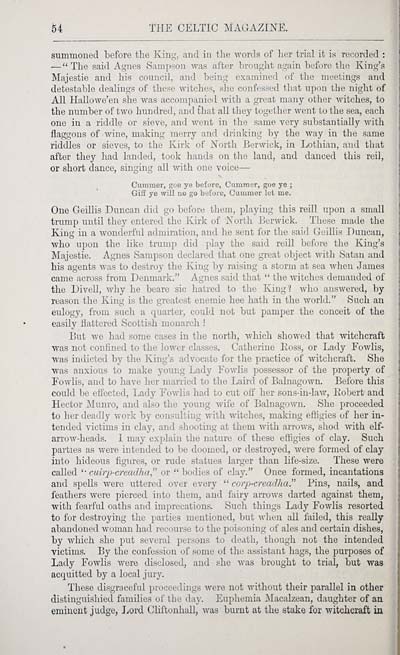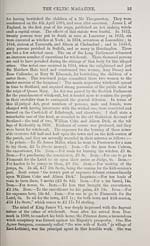Blair Collection > Celtic magazine > Volume 3
(64)
Download files
Complete book:
Individual page:
Thumbnail gallery: Grid view | List view

54 THE CELTIC MAGAZINE.
summoned before the King, and in the words of her trial it is recorded :
— " The said Agnes Sampson was after brought again before the King's
Majestie and his council, and being examined of the meetings and
detestable dealings of these witches, she confessed that upon the night of
All Hallowe'en she was accompanied with a great many other witches, to
the number of two hundred, and {hat all they together went to the sea, each
one in a riddle or sieve, and went in the same very substantially with
flaggons of Avine, making merry and drinking by the way in the same
riddles or sieves, to the Kirk of North Berwick, in Lothian, and that
after they had landed, took hands on the land, and danced this reil,
or short dance, singing all with one voice —
Cummer, goe ye before, Cummer, goe ye ;
Giff ye will no go before, Cummer let me.
One Geillis Duncan did go before them, playing this reill upon a small
trump until they entered the Kirk of North Berwick. These made the
King in a wonderful admiration, and he sent for the said Geillis Duncan,
who upon the like trump did play the said reill before the King's
Majestie. Agnes Sampson declared that one great object with Satan and
his agents was to destroy the King by raising a storm at sea when James
came across from Denmark." Agnes said that " the witches demanded of
the DiveU, why he beare sic hatred to the King? who answered, by
reason the King is the greatest enemie hee hath in the world." Such an
eulogy, from such a quarter, could not but pamper the conceit of the
easily flattered Scottish monarch !
But we had some cases in the north, which showed that witchcraft
was not confined to the lower classes, Catherine Eoss, or Lady Fowlis,
was indicted by the King's advocate for the practice of witchcraft. She
was anxious to make young Lady Eowlis possessor of the property of
Fowlis, and to have her married to the Laird of Balnagown. Before this
could be effected. Lady Fowlis had to cut off her sons-in-law, Eobert and
Hector Munro, and also the young wife of Balnagown. She proceeded
to her deadly work by consulting with witches, making effigies of her in-
tended victims in clay, and shooting at them with arrows, shod with elf-
arrow-heads. 1 may explain the nature of these effigies of clay. Such
parties as were intended to be doomed, or destroyed, were formed of clay
into hideous figures, or rude statues larger than life-size. These were
called '• cuirp-creadlia" or " bodies of clay." Once formed, incantations
and spells were uttered over every " eoi'p-creadha." Pins, nails, and
feathers were pierced into them, and fairy arrows darted against them,
with fearfid. oaths and imprecations. Such things Lady Fowlis resorted
to for destroying the parties mentioned, but when all failed, this reaUy
abandoned woman had recourse to the poisoning of ales and certain dishes,
by Avhich she put several persons to death, though not the intended
victims. By the confession of some of the assistant hags, the purposes of
Lady Fowlis were disclosed, and she was brought to trial, but was
acquitted by a local jury.
These disgraceful proceedings were not without their parallel in other
distinguishied families of the day. Euphemia JMacalzean, daughter of an
eminent judge, Lord Cliftouhall, was burnt at the stake for witchcraft in
summoned before the King, and in the words of her trial it is recorded :
— " The said Agnes Sampson was after brought again before the King's
Majestie and his council, and being examined of the meetings and
detestable dealings of these witches, she confessed that upon the night of
All Hallowe'en she was accompanied with a great many other witches, to
the number of two hundred, and {hat all they together went to the sea, each
one in a riddle or sieve, and went in the same very substantially with
flaggons of Avine, making merry and drinking by the way in the same
riddles or sieves, to the Kirk of North Berwick, in Lothian, and that
after they had landed, took hands on the land, and danced this reil,
or short dance, singing all with one voice —
Cummer, goe ye before, Cummer, goe ye ;
Giff ye will no go before, Cummer let me.
One Geillis Duncan did go before them, playing this reill upon a small
trump until they entered the Kirk of North Berwick. These made the
King in a wonderful admiration, and he sent for the said Geillis Duncan,
who upon the like trump did play the said reill before the King's
Majestie. Agnes Sampson declared that one great object with Satan and
his agents was to destroy the King by raising a storm at sea when James
came across from Denmark." Agnes said that " the witches demanded of
the DiveU, why he beare sic hatred to the King? who answered, by
reason the King is the greatest enemie hee hath in the world." Such an
eulogy, from such a quarter, could not but pamper the conceit of the
easily flattered Scottish monarch !
But we had some cases in the north, which showed that witchcraft
was not confined to the lower classes, Catherine Eoss, or Lady Fowlis,
was indicted by the King's advocate for the practice of witchcraft. She
was anxious to make young Lady Eowlis possessor of the property of
Fowlis, and to have her married to the Laird of Balnagown. Before this
could be effected. Lady Fowlis had to cut off her sons-in-law, Eobert and
Hector Munro, and also the young wife of Balnagown. She proceeded
to her deadly work by consulting with witches, making effigies of her in-
tended victims in clay, and shooting at them with arrows, shod with elf-
arrow-heads. 1 may explain the nature of these effigies of clay. Such
parties as were intended to be doomed, or destroyed, were formed of clay
into hideous figures, or rude statues larger than life-size. These were
called '• cuirp-creadlia" or " bodies of clay." Once formed, incantations
and spells were uttered over every " eoi'p-creadha." Pins, nails, and
feathers were pierced into them, and fairy arrows darted against them,
with fearfid. oaths and imprecations. Such things Lady Fowlis resorted
to for destroying the parties mentioned, but when all failed, this reaUy
abandoned woman had recourse to the poisoning of ales and certain dishes,
by Avhich she put several persons to death, though not the intended
victims. By the confession of some of the assistant hags, the purposes of
Lady Fowlis were disclosed, and she was brought to trial, but was
acquitted by a local jury.
These disgraceful proceedings were not without their parallel in other
distinguishied families of the day. Euphemia JMacalzean, daughter of an
eminent judge, Lord Cliftouhall, was burnt at the stake for witchcraft in
Set display mode to: Large image | Transcription
Images and transcriptions on this page, including medium image downloads, may be used under the Creative Commons Attribution 4.0 International Licence unless otherwise stated. ![]()
| Early Gaelic Book Collections > Blair Collection > Celtic magazine > Volume 3 > (64) |
|---|
| Permanent URL | https://digital.nls.uk/76444295 |
|---|
| Description | Volume III, 1878. |
|---|---|
| Shelfmark | Blair.4 |
| Attribution and copyright: |
|
| Description | A selection of books from a collection of more than 500 titles, mostly on religious and literary topics. Also includes some material dealing with other Celtic languages and societies. Collection created towards the end of the 19th century by Lady Evelyn Stewart Murray. |
|---|
| Description | Selected items from five 'Special and Named Printed Collections'. Includes books in Gaelic and other Celtic languages, works about the Gaels, their languages, literature, culture and history. |
|---|

